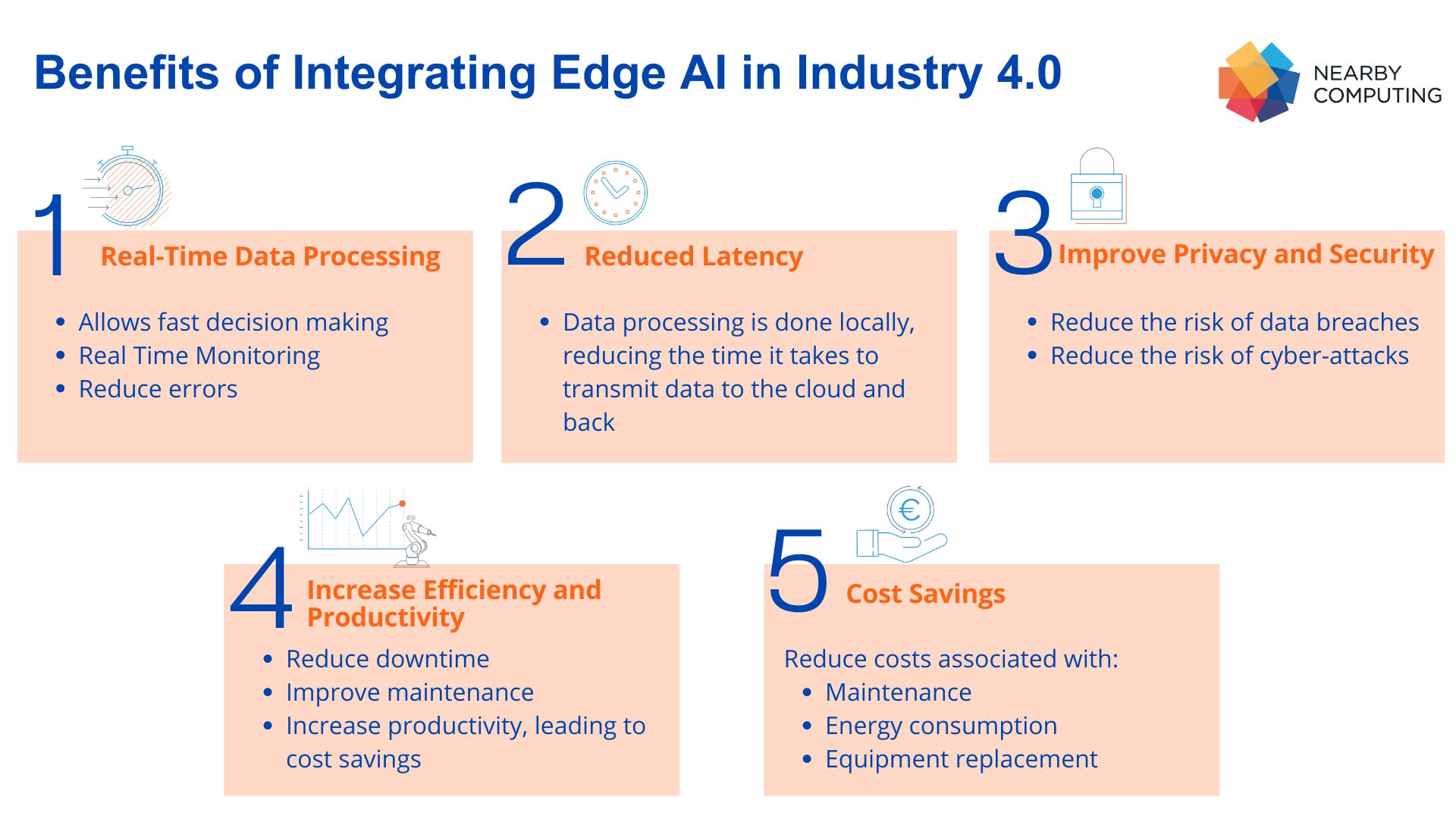Blog | nearby computing
The rise of Edge AI: bringing intelligence closer to the source.
This topic is a rapidly evolving technology that is gaining a foothold in industries worldwide. Edge AI refers to the use of artificial intelligence on devices that are located at the edge of a network, such as sensors, drones, and smartphones. This technology is essential because it allows real-time data processing, which is crucial for many uses cases that rely on fast decision making.
The importance of Edge AI
Edge AI plays a significant role in Industry 4.0, which is the fourth industrial revolution characterized by the integration of advanced technologies into industries. With this, manufacturers can increase efficiency and reduce costs in their production processes. For instance, Edge AI can help detect potential production line issues that are essential in preventing downtime and reducing maintenance costs. Additionally, it can improve safety by detecting and preventing accidents in real-time, reducing the possibility of injuries and loss of life. Prediction is a key feature of AI that enables machines to make intelligent decisions, improve their accuracy over time, and enhance their ability to perform a wide range of tasks, including predictive maintenance capacities.
Edge AI will also be disruptive for the entertainment industry. For example, it can be used in augmented reality (AR) and virtual reality (VR) applications to create immersive experiences. Edge AI can be leveraged to enhance the user experience and enable better performance in games, making them more interactive and engaging.
Use Cases
All industries will in one way or another eventually adopt this technology. Let’s see a few other examples:
- Agriculture: It can be used in agriculture to optimize crop yields and reduce water usage. For example, sensors can be used to collect data on soil moisture levels, temperature, and other environmental factors, which can then be analysed using machine learning algorithms to determine the optimal time and quantities for planting, irrigating, fertilizing, applicating pesticides, and harvesting crops.
- Energy: It can be used in the energy sector to optimize the use of renewable energy sources such as solar and wind power. For example, sensors can be used to collect data on weather conditions, energy production, and energy consumption, which can then be analysed using machine learning algorithms to optimize energy production and reduce costs.
- Finance: It can be used in finance to detect fraud and improve risk management. For example, machine learning algorithms can be used to analyse transaction data in real-time, detecting suspicious activity and preventing fraud before it occurs.
- Manufacturing: It can be used in manufacturing to optimize production processes and reduce downtime. For example, sensors can be used to detect potential equipment failures, which can then be analysed using machine learning algorithms to predict when maintenance is needed and prevent downtime.
- Smart cities: It can be used in smart cities to improve traffic management and reduce congestion. For example, sensors can be used to detect traffic patterns and adjust traffic signals in real-time, reducing wait times and improving traffic flow.
Benefits
There are several benefits, including:
- Real-time data processing: Edge AI enables data processing in real-time, which is critical for many industries that require fast decision making.
- Reduced latency: With Edge AI, data processing is done locally, reducing the time it takes to transmit data to the cloud and back.
- Improved privacy and security: Edge AI ensure that data is processed locally, reducing the risk of data breaches and cyber-attacks.
- Increased efficiency and productivity: Edge AI can help reduce downtime, improve maintenance, and increase productivity, leading to cost savings.
- Cost savings: Edge AI can help reduce costs associated with maintenance, energy consumption, and equipment replacement.

Implementing Edge AI
To implement Edge AI, edge computing is needed. Edge computing is a distributed computing paradigm that brings computation and data storage closer to the location where it is needed, thereby reducing the latency and bandwidth constraints of cloud computing. It allows data to be processed locally on the device or at the edge of the network, saving time and reducing the need for data to be sent to a remote server for processing.
In addition to edge computing, several other technologies are required to deploy Edge AI, including sensors, processors, machine learning algorithms, communication protocols, and cloud computing. Sensors are used to collect data, while processors and machine learning algorithms are used to analyse it. Communication protocols are used to transmit data to the cloud or other devices, while cloud computing is used to store and analyse large amounts of data.
Conclusions
Edge AI is a disruptive technology that has numerous applications in various industries. Its benefits include real-time data processing, improved efficiency, and cost savings. However, deploying Edge AI requires the use of various technologies, including edge computing, sensors, processors, and machine learning algorithms. As Edge AI continues to evolve, it will enable faster and more efficient decision-making, and improve safety and productivity.
Nearby Computing integrates all the power of Edge AI into its orchestration capabilities and has a specific R&I line focused on this exciting topic.




